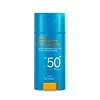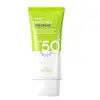What's inside
What's inside
 Key Ingredients
Key Ingredients

 Benefits
Benefits

 Concerns
Concerns

 Ingredients Side-by-side
Ingredients Side-by-side

Dimethicone
EmollientCeresin
Emulsion StabilisingOctocrylene
UV AbsorberSilica
AbrasiveTriethylhexanoin
MaskingEthylhexyl Methoxycinnamate
UV AbsorberDiethylamino Hydroxybenzoyl Hexyl Benzoate
UV FilterOzokerite
Emulsion StabilisingPhenyl Trimethicone
Skin ConditioningButylene Glycol Dicaprylate/Dicaprate
EmollientEthylhexyl Salicylate
UV AbsorberVinyl Dimethicone/Methicone Silsesquioxane Crosspolymer
Euphorbia Cerifera Cera
AstringentBis-Ethylhexyloxyphenol Methoxyphenyl Triazine
Skin ConditioningMethyl Methacrylate Crosspolymer
Microcrystalline Wax
Emulsion StabilisingSorbitan Caprylate
EmulsifyingDipropylene Glycol
HumectantGlycerin
HumectantWater
Skin ConditioningSorbitan Sesquioleate
EmulsifyingCaprylyl Glycol
EmollientHydrogenated Lecithin
EmulsifyingPolyglyceryl-10 Oleate
Skin ConditioningGlycyrrhiza Uralensis Extract
EmollientAdenosine
Skin ConditioningButylene Glycol
HumectantLactobacillus/Soybean Ferment Extract
Skin ConditioningOriganum Vulgare Leaf Extract
Skin ConditioningCinnamomum Cassia Bark Extract
MaskingSalix Alba Bark Extract
AstringentChamaecyparis Obtusa Leaf Extract
Skin ConditioningScutellaria Baicalensis Root Extract
AstringentPortulaca Oleracea Extract
Skin ConditioningAloe Barbadensis Leaf Extract
EmollientBrassica Oleracea Italica Extract
AstringentCitrus Nobilis Fruit Extract
MaskingCamellia Sinensis Leaf Extract
AntimicrobialPropanediol
SolventEctoin
Skin ConditioningArgania Spinosa Kernel Oil
EmollientGossypium Herbaceum Seed Oil
Skin ConditioningArctium Lappa Seed Oil
EmollientLavandula Angustifolia Oil
MaskingCitrus Limon Peel Oil
MaskingCitrus Nobilis Peel Oil
MaskingDimethicone, Ceresin, Octocrylene, Silica, Triethylhexanoin, Ethylhexyl Methoxycinnamate, Diethylamino Hydroxybenzoyl Hexyl Benzoate, Ozokerite, Phenyl Trimethicone, Butylene Glycol Dicaprylate/Dicaprate, Ethylhexyl Salicylate, Vinyl Dimethicone/Methicone Silsesquioxane Crosspolymer, Euphorbia Cerifera Cera, Bis-Ethylhexyloxyphenol Methoxyphenyl Triazine, Methyl Methacrylate Crosspolymer, Microcrystalline Wax, Sorbitan Caprylate, Dipropylene Glycol, Glycerin, Water, Sorbitan Sesquioleate, Caprylyl Glycol, Hydrogenated Lecithin, Polyglyceryl-10 Oleate, Glycyrrhiza Uralensis Extract, Adenosine, Butylene Glycol, Lactobacillus/Soybean Ferment Extract, Origanum Vulgare Leaf Extract, Cinnamomum Cassia Bark Extract, Salix Alba Bark Extract, Chamaecyparis Obtusa Leaf Extract, Scutellaria Baicalensis Root Extract, Portulaca Oleracea Extract, Aloe Barbadensis Leaf Extract, Brassica Oleracea Italica Extract, Citrus Nobilis Fruit Extract, Camellia Sinensis Leaf Extract, Propanediol, Ectoin, Argania Spinosa Kernel Oil, Gossypium Herbaceum Seed Oil, Arctium Lappa Seed Oil, Lavandula Angustifolia Oil, Citrus Limon Peel Oil, Citrus Nobilis Peel Oil
Water
Skin ConditioningZinc Oxide
Cosmetic ColorantIsononyl Isononanoate
EmollientCaprylyl Methicone
Skin ConditioningPropylheptyl Caprylate
EmollientButylene Glycol
HumectantIsododecane
EmollientButyloctyl Salicylate
Skin ConditioningDisiloxane
Skin ConditioningCI 77891
Cosmetic ColorantAcrylates Copolymer
C12-15 Alkyl Benzoate
AntimicrobialPolymethyl Methacrylate
Polyhydroxystearic Acid
EmulsifyingAcrylates/Polytrimethylsiloxymethacrylate Copolymer
Skin ConditioningDisteardimonium Hectorite
StabilisingMagnesium Sulfate
Dimethicone
Emollient1,2-Hexanediol
Skin ConditioningPoly C10-30 Alkyl Acrylate
Emulsion StabilisingPolyglyceryl-3 Polydimethylsiloxyethyl Dimethicone
Skin ConditioningTriethoxycaprylylsilane
Aluminum Hydroxide
EmollientStearic Acid
CleansingPolyglyceryl-6 Polyhydroxystearate
EmulsifyingPolyglyceryl-6 Polyricinoleate
EmulsifyingPolyglyceryl-2 Dipolyhydroxystearate
Skin ConditioningCeresin
Emulsion StabilisingHydroxyacetophenone
AntioxidantPolyglycerin-6
HumectantTocopherol
AntioxidantAscorbyl Palmitate
AntioxidantAllantoin
Skin ConditioningCeramide NP
Skin ConditioningPanthenol
Skin ConditioningSodium Hyaluronate
HumectantDipropylene Glycol
HumectantMadecassic Acid
Skin ConditioningAsiatic Acid
Skin ConditioningAsiaticoside
AntioxidantVanilla Tahitensis Fruit Extract
Skin ConditioningTheobroma Cacao Seed Extract
AntioxidantWater, Zinc Oxide, Isononyl Isononanoate, Caprylyl Methicone, Propylheptyl Caprylate, Butylene Glycol, Isododecane, Butyloctyl Salicylate, Disiloxane, CI 77891, Acrylates Copolymer, C12-15 Alkyl Benzoate, Polymethyl Methacrylate, Polyhydroxystearic Acid, Acrylates/Polytrimethylsiloxymethacrylate Copolymer, Disteardimonium Hectorite, Magnesium Sulfate, Dimethicone, 1,2-Hexanediol, Poly C10-30 Alkyl Acrylate, Polyglyceryl-3 Polydimethylsiloxyethyl Dimethicone, Triethoxycaprylylsilane, Aluminum Hydroxide, Stearic Acid, Polyglyceryl-6 Polyhydroxystearate, Polyglyceryl-6 Polyricinoleate, Polyglyceryl-2 Dipolyhydroxystearate, Ceresin, Hydroxyacetophenone, Polyglycerin-6, Tocopherol, Ascorbyl Palmitate, Allantoin, Ceramide NP, Panthenol, Sodium Hyaluronate, Dipropylene Glycol, Madecassic Acid, Asiatic Acid, Asiaticoside, Vanilla Tahitensis Fruit Extract, Theobroma Cacao Seed Extract
 Reviews
Reviews

Ingredients Explained
These ingredients are found in both products.
Ingredients higher up in an ingredient list are typically present in a larger amount.
Butylene Glycol (or BG) is used within cosmetic products for a few different reasons:
Overall, Butylene Glycol is a safe and well-rounded ingredient that works well with other ingredients.
Though this ingredient works well with most skin types, some people with sensitive skin may experience a reaction such as allergic rashes, closed comedones, or itchiness.
Learn more about Butylene GlycolCeresin is a wax derived from ozokerite. It is an alternative to beeswax.
The most common process of creating ceresin is by using heat and sulfuric acid.
Dimethicone is a type of synthetic silicone created from natural materials such as quartz.
What it does:
Dimethicone comes in different viscosities:
Depending on the viscosity, dimethicone has different properties.
Ingredients lists don't always show which type is used, so we recommend reaching out to the brand if you have questions about the viscosity.
This ingredient is unlikely to cause irritation because it does not get absorbed into skin. However, people with silicone allergies should be careful about using this ingredient.
Note: Dimethicone may contribute to pilling. This is because it is not oil or water soluble, so pilling may occur when layered with products. When mixed with heavy oils in a formula, the outcome is also quite greasy.
Learn more about DimethiconeDipropylene Glycol is a synthetically created humectant, stabilizer, and solvent.
This ingredient helps:
Dipropylene glycol is technically an alcohol, but it belongs to the glycol family (often considered part of the ‘good’ alcohols). This means it is hydrating and gentle on skin unlike drying solvent alcohols like denatured alcohol.
As a masking agent, Dipropylene Glycol can be used to cover the smell of other ingredients. However, it does not have a scent.
Studies show Dipropylene Glycol is considered safe to use in skincare.
Learn more about Dipropylene GlycolWater. It's the most common cosmetic ingredient of all. You'll usually see it at the top of ingredient lists, meaning that it makes up the largest part of the product.
So why is it so popular? Water most often acts as a solvent - this means that it helps dissolve other ingredients into the formulation.
You'll also recognize water as that liquid we all need to stay alive. If you see this, drink a glass of water. Stay hydrated!
Learn more about Water